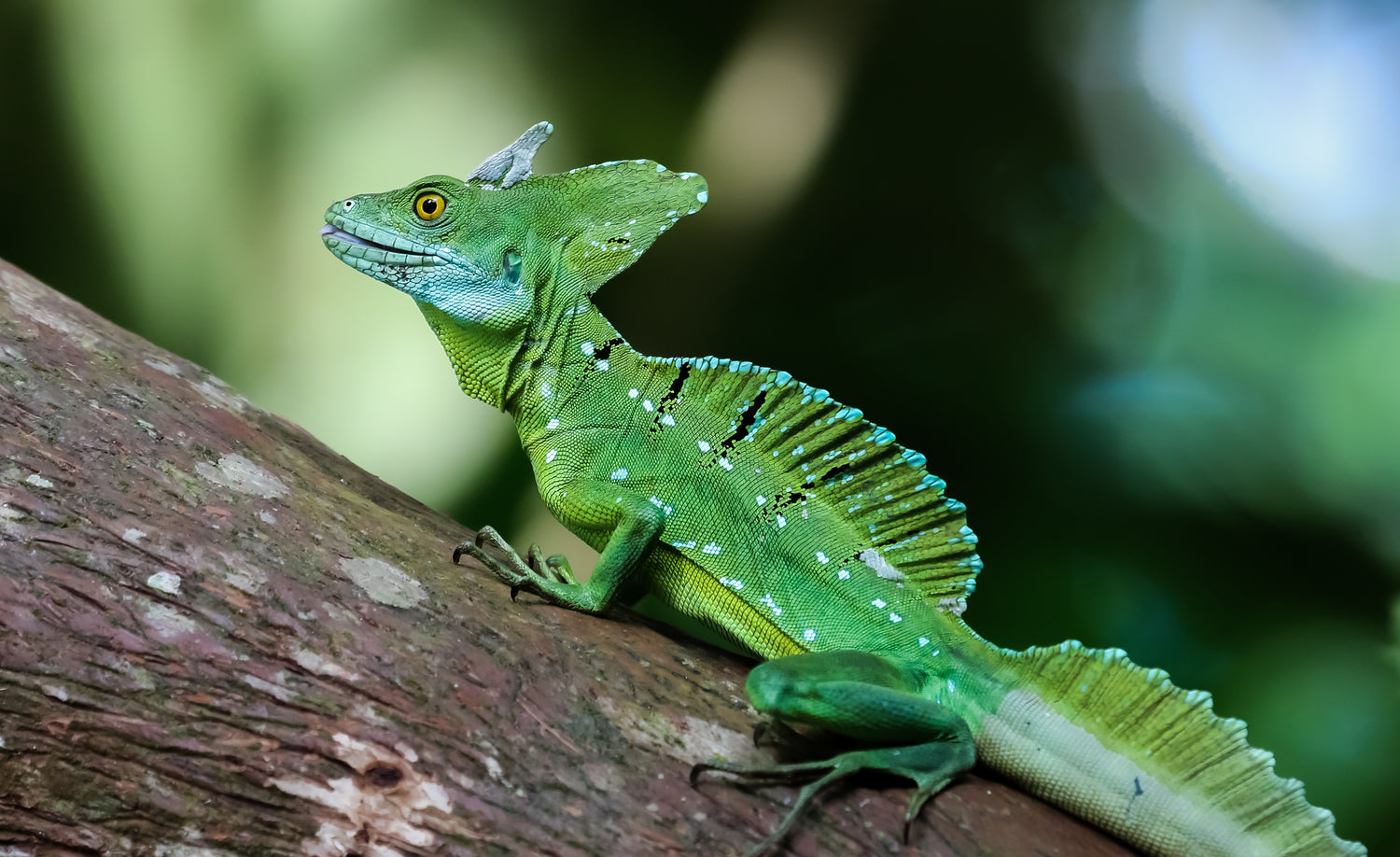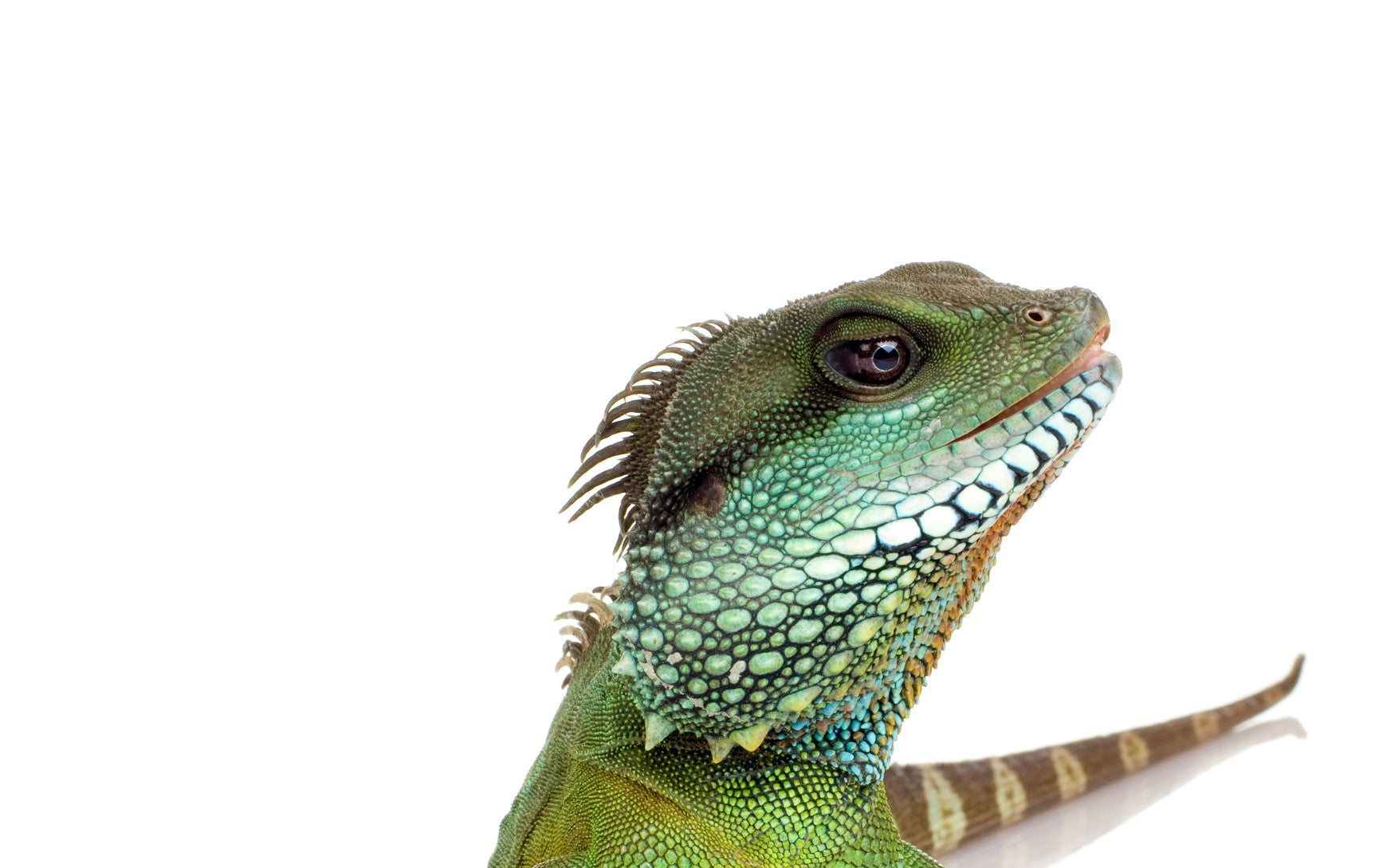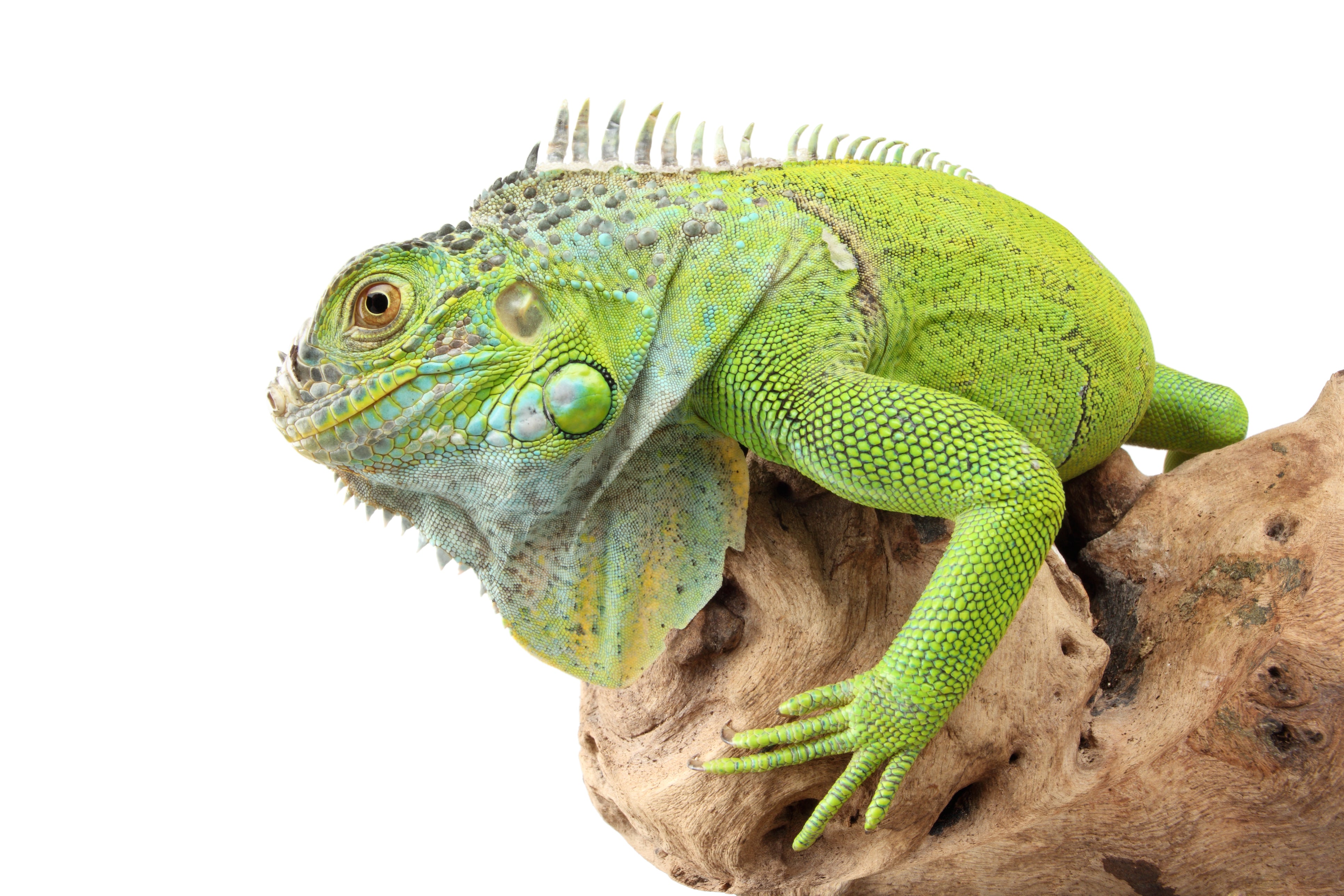Green basilisks (Basiliscus plumifrons) are large, diurnal, arboreal reptiles native to Central America, where they can be found in tropical forest areas near bodies of fresh water.
Green basilisks are the most colorful of the basilisks, with brilliant green bodies interrupted with small aqua and black spots and striking yellow eyes. Mature males have crests on their head, back, and tail, while females only have a small one on their head. These lizards are generally 2.5-3’ long.
Green basilisks require lots of space and aren’t very handleable, making them a better display animal than a family “pet”. However, for those willing to put in the expense of a proper enclosure and simply want a lovely specimen to look at, they can be rewarding to keep. With good care, they live 10-15 years in captivity.
How much space do green basilisks need?
A single green basilisk should be housed in no smaller than a 6’L x 2’W x 4’H enclosure. If at all possible, larger is strongly recommended. This size of enclosure may not be readily available for purchase, so you may need to order one custom-made or build your own.
Cohabitation (keeping multiple green basilisks in the same enclosure) is not recommended.
Do green basilisks need UVB?
UVB is required for green basilisks to stay healthy. Aside from helping provide a day/night cycle and providing an infinite supply of vitamin D, UVB is also good for the lizard’s overall health. Here are the best UVB bulbs for green basilisks housed in a 6’L x 2’W x 4’H enclosure:
- Arcadia T5 HO Desert 12%, 34”
- Zoo Med Reptisun T5 HO 10.0, 34”
If the UVB is mounted over mesh, place the basking branch so the basilisk’s back will be 13-15” below the lamp. If the UVB is mounted inside the enclosure, place the basking branch so the basilisk’s back will be 17-18” below the lamp.
The UVB bulb should be housed in a reflective fixture like the Arcadia ProT5 or Vivarium Electronics T5 HO, and placed on the basking side along with the heat lamp. Make sure that the fixture your UVB bulb is housed in does not have a clear plastic bulb cover.
Since green basilisks are active during the day, it’s beneficial to provide an additional daylight-spectrum lamp to make sure the enclosure is brightly illuminated. This is extra important since you will be using such a large enclosure, and may help your basilisk keep its bright colors. Use 4’’ of strong 6500K LED or T5 HO fluorescent plant grow lights for best results.
Lights should be on for 12 hours/day.
What basking temperatures do green basilisks need?
Green basilisks need a basking area temperature of 90-95°F and a cool side temperature between 75-80°F. Average temperature in the enclosure should stay between 80-85°F. Temperatures should be measured with digital probe thermometers, with probes placed on the basking spot and the floor on the cool side.
The basking surface itself should be a thick, sturdy wood branch placed near the top per the specifications listed previously.
Provide heat for your pet by imitating the sun with a cluster of halogen heat lamps placed on one side of the enclosure. You will need enough lamps to evenly heat an area at least the size of the lizard’s body. Do not use heat mats, red bulbs, or blue bulbs, as these are not as effective.
Nighttime temps should be no lower than 75°F. If needed, a lightless heat source such as a radiant heat panel can be used to maintain the minimum air temperature.
What humidity levels do green basilisks need?
Green basilisks are a tropical species that needs a humid environment to stay healthy. Average humidity levels should be between 60-70%. Humidity should be measured with a digital probe hygrometer with the probe in the middle of the terrarium. Daily misting with a pressure sprayer and/or using a humidifier connected to a humidistat is helpful for maintaining high humidity.
Reptile humidifiers and foggers should only be used with distilled water and require frequent disinfecting to keep your reptile from getting sick.
Green basilisks naturally live near bodies of water in the wild. They are very comfortable in the water — they are excellent swimmers and can hold their breath for at least 20 minutes while submerged. For this reason, you will need to provide a pool of water for your green basilisk to use for swimming, soaking, and drinking.
At very least, the pool needs to be 1/2 to 1/3 the length of the enclosure and large enough for your lizard to completely submerge (at least 6” deep). Of course, deeper is better if you can provide it. Change out the water once weekly or whenever it gets soiled, and give the basin a good scrub with disinfectant before refilling. Using a siphon (or better yet, a mechanical water pump) and a hose will make emptying and refilling the pool much easier.
What substrate is good for green basilisks?
Although green basilisks spend a lot of time either climbing among branches or swimming down below, using substrate in the enclosure will cover the floor and help provide a cushion in the unlikely event that the lizard falls from its perch. It also helps maintain humidity!
We recommend the following substrates for green basilisks:
You can even use a thick layer of fluffy, moistened sphagnum moss!
Substrate should be at least 4” deep and completely replaced every 3-4 months. Remove poop and urates daily, along with any contaminated substrate.
What décor can you use in a green basilisk enclosure?
Green basilisks do not do well in enclosures where they can’t hide, climb, or perform other instinctive behaviors. And heaven forbid that it’s boring! One of the best ways you can help your pet be happy in its enclosure is to fill it with things for the lizard to use and interact with.
At bare minimum, you will need a sturdy basking branch, swimming pool, somewhere to hide, and a thick layer of substrate. However, it’s best to include other items, such as:
- additional climbing branches
- raised platforms
- hollow logs
- additional hiding places (dog/cat kennels can work well)
- live or artificial foliage
All climbing branches should be securely anchored into the walls/floor of the enclosure to prevent collapse.
What do green basilisks eat?
Green basilisks are omnivorous, which means that they need to eat both animal- and plant-based foods to get the nutrition that they need. Although they mostly eat insects, they are also known to eat small animals (other lizards, snakes, fish, rodents, birds, frogs) as well as fruit and some fresh greens. How much they need to eat varies depending on age:
- Hatchlings (<3 months old) — Insects daily
- Juveniles (<16” long) — Insects and salad every other day
- Subadults and adults (>16” long) — Insects every 3-5 days, salad daily
For a healthy, happy, colorful green basilisk, offer as much dietary variety as you can!
Protein options for green basilisks: crickets, discoid roaches, dubia roaches, earthworms, grasshoppers, hornworms, silkworms, mealworms, superworms, snails (captive-bred only), pinkie/fuzzy mice, whole fish, chicks, feeder anoles
Vegetable options for green basilisks: collard greens, cactus pads, spring mix, arugula, kale, alfalfa, bok choy, carrot greens, spinach, dandelion greens/flowers, hibiscus greens/flowers
Due to its high sugar content, fruit should be used as a treat. Options include berries, mango, cantaloupe, and papaya.
Supplements
You will also need calcium and vitamin supplements to prevent your lizard from developing a deficiency. We recommend Repashy Calcium Plus LoD, lightly dusted on all insects.
Do green basilisks like to be handled?
Truthfully, few reptiles actually “like” to be handled. Green basilisks are well known for not being very handleable, as they are defensive around humans and tough to tame. If you try to grab them, they may deliver a nasty bite! However, taming is not impossible. First you must convince the lizard to trust you.
The key to building a trusting relationship with your pet is to provide as many positive interactions as possible. Offering food from feeding tweezers works well as an initial bribe, and it’s best to get the lizard to come to you rather than simply grabbing it.
When you start handling your basilisk, be gentle. Don’t grab the lizard from above, because that will make it afraid of you. Instead, approach from the side and scoop from below. Support as much of its body as possible, especially its feet. Handle inside the enclosure only at first. Start with very short handling sessions in the beginning, then gradually make them longer as your pet becomes more accustomed to you. 10 minutes of interaction daily usually creates a fairly handleable basilisk. If you are worried about bites, wear a pair of thick leather gloves for handling.
*This care sheet contains only very basic information. Although it’s a good introduction, please do further research with high-quality sources to obtain additional information on caring for this species.




Leave a comment
This site is protected by hCaptcha and the hCaptcha Privacy Policy and Terms of Service apply.